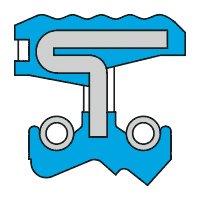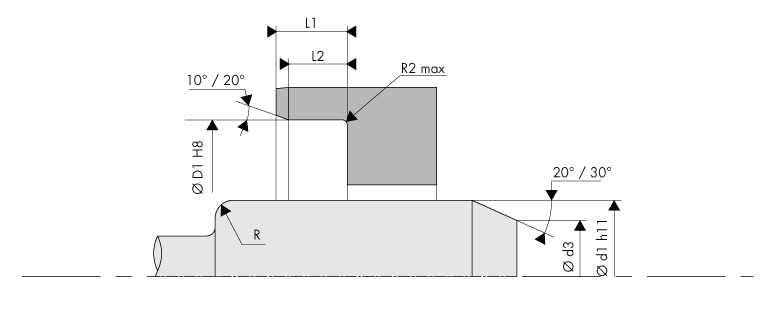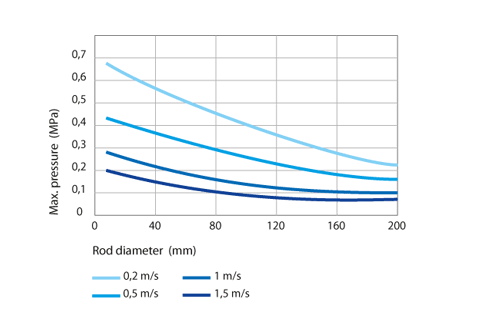DCW4



Description
The DCW4 profile is a shaft seal composed of a single metal cage with rubber grooves on the outside of the cage and a double sealing lip suitable for linear movements, the fluids being separated by the integrated springs.
Advantages
Very good static sealing
Very good thermal expansion compensation
Greater roughness is allowed in the housing
Reduced risk of corrosion
Easy to assemble with very limited bounce-back effect
Sealing for low and high viscosity fluids
Modern sealing lips with low radial forces
Sealing lips designed for linear movements
Fluid separation system
Technical data
Applications
All types of linear applications
Shock absorbers
Power-assisted steering
Materials
Rubbers
FKM 75 - 80 Shore A
HNBR 75 - 80 Shore A
NBR 75 - 80 Shore A
Metal cage
Steel - AISI 1010
Steel - DC01 C490
Steel - DC01 C590
Spring
Steel - AISI 1070 - 1090
Stainless steel - AISI 316
for use
Dimensions

Materials
Metal cage - Spring
The table below shows the materials that we can offer for metal cages and springs.
| Application | Material | Standard | Characteristics |
|---|---|---|---|
| Metal cage | Non-alloy standard steel | AISI 1010 (DIN 1624) |
Cold rolled steel |
| Metal cage | Nickel chrome steel | AISI 304 (DIN 1.4301 - V2A) |
Standard stainless steel |
| Metal cage and spring | Chrome-nickel-molybdenum steel | AISI 316 (DIN 1.4401 - V4A) |
Stainless steel highly resistant to corrosion |
| Spring | Steel for springs | AISI 1070 - 1090 DIN 17223 |
Cold drawn carbon steel wire |
| Spring | Nickel chrome steel | AISI 302 (DIN 1.4300) |
Stainless steel for springs with a high carbon content |
Rubbers
ACM (Polyacrylate)
Polymers containing ethyl acrylate (or butyl acrylate) have a small amount of monomer, which is necessary for cross-linking; ACM is a material with better heat resistance than NBR. It is often used for automatic gearboxes.
| Chemical resistance | Mineral oils (motor oils, gear box oils, ATF oils) Atmospheric and ozone agents |
|---|---|
| Compatibility issue | Glycol-based brake fluids (Dot 3 & 4) Aromatic and chlorinated hydrocarbons Water and steam Acids, alkalis and amines |
| Temperature range | -25°C to + 150°C (short-term peak at +160°C) -35°C / +150°C with particular ACMs |
AEM (ethylene acrylate rubber)
As a methyl acrylate and ethylene copolymer, AEM is considered to be more resistant to heat than ACM. Its characteristics make it an intermediary between ACM and FKM.
| Chemical resistance | Cooling fluids Aggressive mineral oils Atmospheric agents Water |
|---|---|
| Compatibility issue | Aromatic solvents Strong acids Brake fluids Gearbox oils ATF oils |
| Temperature range | - 40°C to + 150°C |
CR (Polychloroprene)
This CR-based rubber is used in the refrigeration industry and for ventilation systems. This chloroprene was the first synthetic rubber to be developed and marketed.
| Chemical resistance | Paraffinic mineral oils Silicone oils and greases Water and water-based solvents for use at low temperatures Refrigerant fluids Ammoniac Carbon dioxide Atmospheric and ozone agents |
|---|---|
| Limited chemical resistance | Naphthenic mineral oils Aliphatic hydrocarbons (propane, butane, petroleum) Glycol-based brake fluids |
| Compatibility issue | Aromatic hydrocarbons (benzene) Chlorinated hydrocarbons (trichlorethylene) Polar solvents (ketone, acetone, acetic acid, ethylene-ester) |
| Temperature range | -40°C / +100°C (short-term peak at +120°C) |
EPDM (Ethylene Propylene Diene Monomer rubber)
As an Ethylene Propylene Diene Monomer copolymer, EPDM is commonly used for hot water taps, cooling systems, brake systems, dishwashers and washing machines.
| Chemical resistance | Hot water and steam up to +150°C Glycol-based brake fluids (Dot 3 & 4) and silicone-based brake fluids (Dot 5) Organic and inorganic acids Cleaning agents, sodium and potassium alkalis Hydraulic fluids (HFD-R) Silicone oils and greases Polar solvents (alcohols, ketones and esters) Atmospheric and ozone agents |
|---|---|
| Compatibility issue | Mineral oils and greases Hydrocarbons Low impermeability to gas |
| Temperature range | -45°C / +150°C (short-term peak at +175°C) |
FFKM (perfluorinated rubber)
FFKM has the best characteristics for resistance to high temperatures, with an excellent chemical inertia. This FKM-based rubber is very often used for high-temperature hydraulic and pneumatic systems, industrial valves, injection/fuel systems, motor seals and high-vacuum systems.
| Chemical resistance | Aliphatic and aromatic hydrocarbons Polar solvents (ketones, esters and ethers) Organic and inorganic acids Water and steam High-vacuum system |
|---|---|
| Compatibility issue | Coolants (R11, R12, R13, R113, R114, etc.) PFPE |
| Temperature range | -15°C/+320°C |
FKM (fluorinated rubber)
Depending on their structure and fluorine content, the chemical resistance and resistance to the cold in fluororubbers can vary. This FKM-based rubber is very often used for high-temperature hydraulics and pneumatics, for industrial valves, injection/fuel systems, motor seals and high-vacuum systems.
| Chemical resistance | Mineral oils and greases, ASTM n°1, IRM 902 and IRM 903 oils. Fire-resistant liquids (HFD) Silicone oils and greases Mineral and vegetable oils and greases Aliphatic hydrocarbons (propane, butane, petroleum) Aromatic hydrocarbons (benzene, toluene) Chlorinated hydrocarbons (trichlorethylene) Fuel (including high alcohol content) Atmospheric and ozone agents |
|---|---|
| Compatibility issue | Glycol-based brake fluids Ammonia gas Organic acids with a low molecular weight (formic and acetic acids) |
| Temperature range | -20°C / +200°C (short-term peak at +230°C) -40°C / +200°C with particular FKMs |
FVMQ (fluorosilicone rubber)
The FVMQ has mechanical and physical properties that are very similar to those of the VMQ. However, the FVMQ offers better resistance to fuels and mineral oils. However, resistance to hot air is not as good as that of the VMQ.
| Chemical resistance | Aromatic mineral oils (IRM 903 oil) Fuels Aromatic hydrocarbons with low molecular weights (benzene, toluene) |
|---|---|
| Temperature range | -70°C/+175°C |
HNBR (Hydrogenated Nitrile Butadiene Rubber)
This HNBR-based rubber is obtained through selective hydrogenation of the NBR's butadiene groups. It is commonly used for power-assisted steering and for air conditioning.
| Chemical resistance | Aliphatic hydrocarbons Mineral and vegetable oils and greases Fire-resistant fluids (HFA, HFB and HFC) Diluted acids, saline solutions and bases for operation at an average temperature Water and steam up to +150°C Atmospheric and ozone agents |
|---|---|
| Compatibility issue | Chlorinated hydrocarbons Polar solvents (ketones, esters and ethers) Strong acids |
| Temperature range | -30°C / +150°C (short-term peak at +160°C) -40°C / +150°C with particular HNBRs |
NBR (Nitrile Butadiene Rubber)
Nitrile rubber (NBR) is the general term for acrylonitrile-butadiene copolymer. The ACN content can vary between 18% and 50%. While the acrylonitrile content is important, the resistance to oil and fuel is more so. Conversely, the elasticity and compression set are not as good. The NBR has good mechanical properties and good wear resistance. However, its resistance to atmospheric agents and the ozone is relatively low.
| Chemical resistance | Aliphatic hydrocarbons (propane, butane, petroleum, diesel fuel) Mineral oils and greases Fire-resistant fluids (HFA, HFB and HFC) Diluted acids, low-temperature alkaline and saline solutions Water (up to +100°C max) |
|---|---|
| Compatibility issue | Fuels with high aromatic content Aromatic hydrocarbons (benzene) Chlorinated hydrocarbons (trichlorethylene) Polar solvents (ketone, acetone, acetic acid, ethylene-ester) Strong acids Glycol-based brake fluids Atmospheric and ozone agents |
| Temperature range | -30°C / +100°C (short-term peak at +120°C) -40°C / +100°C with particular NBRs |
VMQ (silicone rubber: methyl vinyl polysiloxane)
This FVMQ-based rubber is very often used in fuel systems.
| Chemical resistance | Animal and vegetable oils and greases Water for operation at an average temperature Diluted saline solutions Atmospheric and ozone agents |
|---|---|
| Compatibility issue | Superheated steam up to +120°C Chlorinated hydrocarbons with a low molecular weight (trichlorethylene) Aromatic hydrocarbons (benzene, toluene) |
| Temperature range | -60°C / +200°C (short-term peak at +230°C) |
The table below gives an overview of the physical, chemical and mechanical characteristics for each of the materials.
| Characteristics/Materials | ACM | AEM | CR | EPDM | FFKM | FKM | FVMQ | HNBR | NBR | VMQ |
|---|---|---|---|---|---|---|---|---|---|---|
| Abrasion resistant | 2 | 3 | 2 | 2 | 4 | 2 | 4 | 2 | 2 | 4 |
| Resistance to acids | 4 | 3 | 2 | 2 | 1 | 1 | 3 | 1 | 3 | 3 |
| Chemical resistance | 4 | 2 | 2 | 1 | 1 | 1 | 1 | 2 | 2 | 2 |
| Resistance to cold | 4 | 2 | 2 | 2 | 3 | 4 | 2 | 2 | 2 | 2 |
| Dynamic properties | 3 | 3 | 3 | 2 | 3 | 2 | 4 | 1 | 2 | 4 |
| Electrical properties | 3 | 3 | 3 | 2 | 1 | 4 | 1 | 3 | 3 | 1 |
| Flame resistant | 4 | 4 | 2 | 4 | 1 | 1 | 2 | 4 | 4 | 3 |
| Heat resistant | 1 | 1 | 2 | 2 | 1 | 1 | 1 | 1 | 2 | 1 |
| Sealing water | 1 | 1 | 2 | 2 | 2 | 2 | 4 | 2 | 2 | 4 |
| Oil resistant | 1 | 3 | 2 | 4 | 1 | 1 | 2 | 1 | 1 | 2 |
| Ozone resistant | 1 | 1 | 2 | 1 | 1 | 1 | 1 | 2 | 4 | 1 |
| Tearing resistant | 2 | 3 | 3 | 1 | 4 | 3 | 4 | 2 | 2 | 4 |
| Traction resistant | 3 | 2 | 2 | 1 | 2 | 1 | 3 | 1 | 2 | 4 |
| Water/vapour resistant | 4 | 4 | 3 | 1 | 2 | 3 | 3 | 1 | 2 | 3 |
| Resistance to atmospheric agents | 1 | 1 | 1 | 1 | 1 | 1 | 1 | 2 | 3 | 1 |
1. Excellent properties 2. Good properties 3. Average properties 4. Poor properties
Chemical compatibility
A "Chemical compatibility guide" catalogue can be downloaded from the Documentation section. You can also use our online "Chemical compatibility" tool free of charge.
These two tools give you the option of measuring the behaviour of our materials that come into contact with the majority of existing fluids. The data displayed is the result of rigorous testing of the ambient temperature and in consultation with previous publications. Test results are not fully representative due to the specific features of your application. The tests performed actually do not consider additives and impurities that may exist under the actual conditions of use, nor the potential elevation of temperatures. Other parameters can also alter the behaviour of our materials, such as the hardness, persistence, abrasion, etc. We therefore recommend performing your own tests to verify the compatibility of our materials according to your specific application. Our technical team can provide you with any additional information.
Conditions for use
Speed - Pressure
We recommend using seals designed for linear movements at maximum speed of 1.5 m/s and pressures that do not exceed 0.65 MPa. These approximate values cannot be interpreted at the same time.
The table below sets out the connection between the permissible speeds and pressures. For more stringent applications, we recommend contacting our experts.

Temperature
The table below indicates the temperature limits, depending on the materials and fluids used.
| Media | Maximum temperature, depending on the materials | ||||||
|---|---|---|---|---|---|---|---|
| ACM | AEM | EPDM | FKM | HNBR | NBR | ||
| Mineral oils | Oils for motors | +130°C | +130°C | - | +170°C | +130°C | +100°C |
| Oils for gearboxes | +120°C | +130°C | - | +150°C | +110°C | +80°C | |
| Oils for hypoid gears | +120°C | +130°C | - | +150°C | +110°C | +80°C | |
| ATF oils | +120°C | +130°C | - | +170°C | +130°C | +100°C | |
| Hydraulic oils | +120°C | +130°C | +150°C | +130°C | +90°C | ||
| Greases | - | +130°C | - | - | +100°C | +90°C | |
| Fire-resistant fluids |
HFA group - Emulsion with more than 80% water | - | - | - | - | +70°C | +70°C |
| HFB group - Opposite solution (water in oil) | - | - | - | - | +70°C | +70°C | |
| HFC group - Polymer aqueous solution | - | - | +60°C | - | +70°C | +70°C | |
| HFD group - Water-free synthetic fluids | - | - | - | +150°C | - | - | |
| Other fluids | EL + L heating oil | - | - | - | - | +100°C | +90°C |
| Air | +150°C | +150°C | +150°C | +200°C | +130°C | +90°C | |
| Water | - | - | +150°C | +100°C | +100°C | +90°C | |
| Water for washing | - | - | +130°C | +100°C | +100°C | +100°C | |
| Temperature range | Min. | -25°C | -40°C | -45°C | -20°C | -30°C | -30°C |
| Max. | +150°C | +150°C | +150°C | +200°C | +150°C | +100°C | |
The lip of the seal for linear movement is subjected to a higher temperature due to the movement of the rod, and the significant pressure and friction on the mechanical parts. Good lubrication is therefore necessary to allow for a better release of heat and thus limits the temperature rise in the parts subjected to friction.
Fluids
Mineral oils
In general, this type of oil has few additives and is therefore perfectly suitable for all of the rubbers used for the rotary shaft seals. The following oils are suitable for revolving applications:
- motor oils
- gearbox oils
- hypoid oils
- ATF oils for automatic gearboxes
- transmission oils
synthetic oils
This type of oil is used to improve different characteristics such as the resistance to ageing, resistance to high temperatures, viscosity, etc. and has a good compatibility with the majority of rubbers used for the seals for the rotary shaft. Tests may need to be performed beforehand to measure the degree of compatibility of this type of oil with the materials used. Among the synthetic oils are:
- brake fluids
- fluids for automatic gearboxes
- fluids for suspensions
- fluids for steering systems
- fluids for hydraulic transmissions
Hypoid oils
This type of oil contains special components such as EP additives. These enable lubrication and thus limit any seizing at the bearings, for example. When affected by heat, these additives have the tendency to lead to deposits on the sealing lip. That is why we recommend using seals for the rotating shaft with a sealing lip comprising return pumping leads in order to limit the increase in temperature and above all, to reduce these potential carbon deposits.
Aggressive fluids
It is critical to choose the correct material to better resist different aggressive fluids (acids, solvents, chemical products, etc.). For applications in a linear environment, we recommend using materials such as FKM rather than NBR. For operations that are dry or use very little lubrication, and where the rubbers do not resist certain aggressive fluids, we advise you to use our PTFE seals for the rotary shaft.
Only on request
